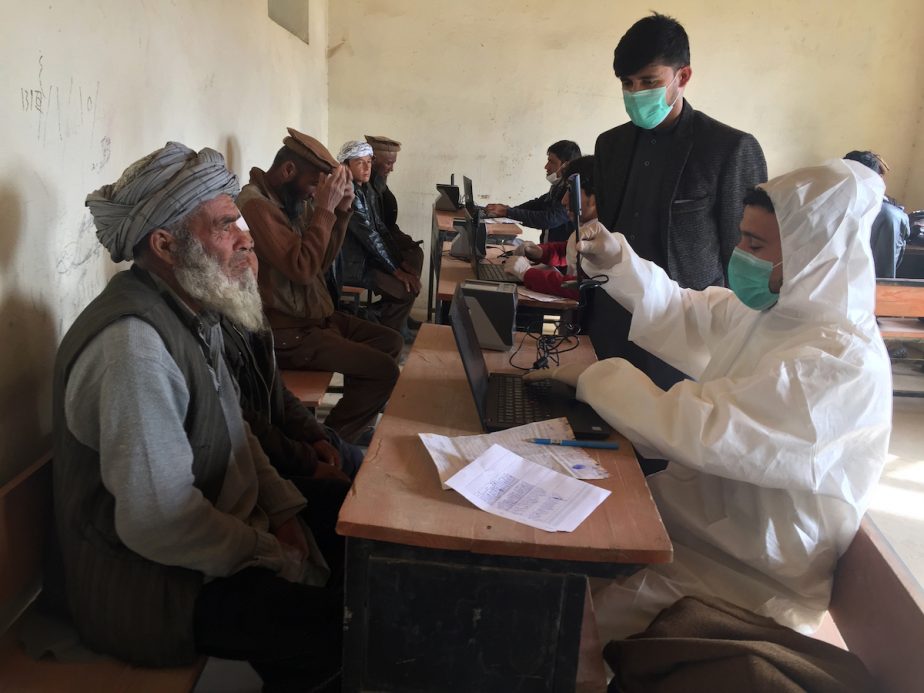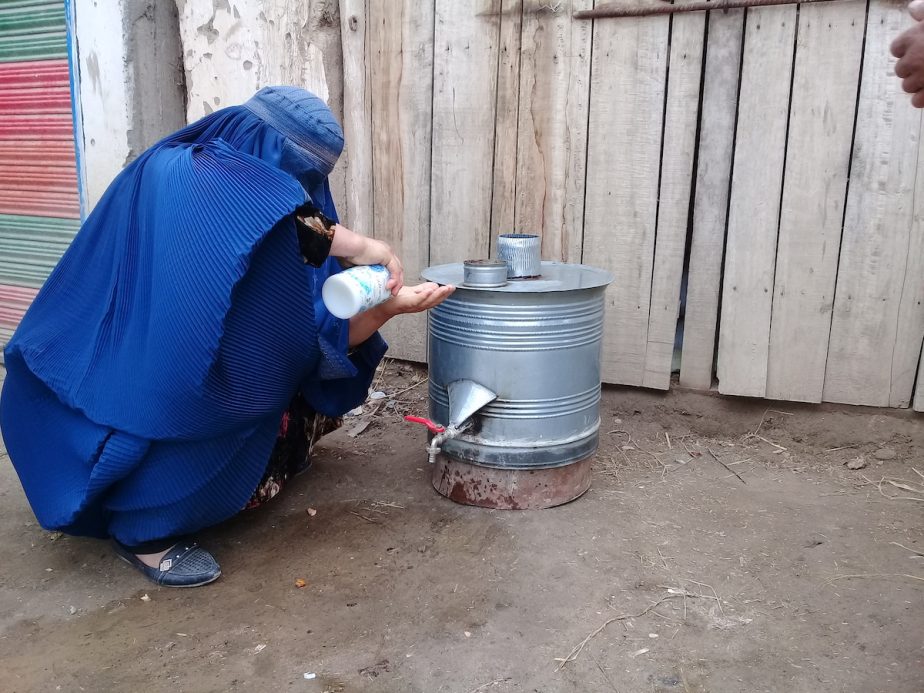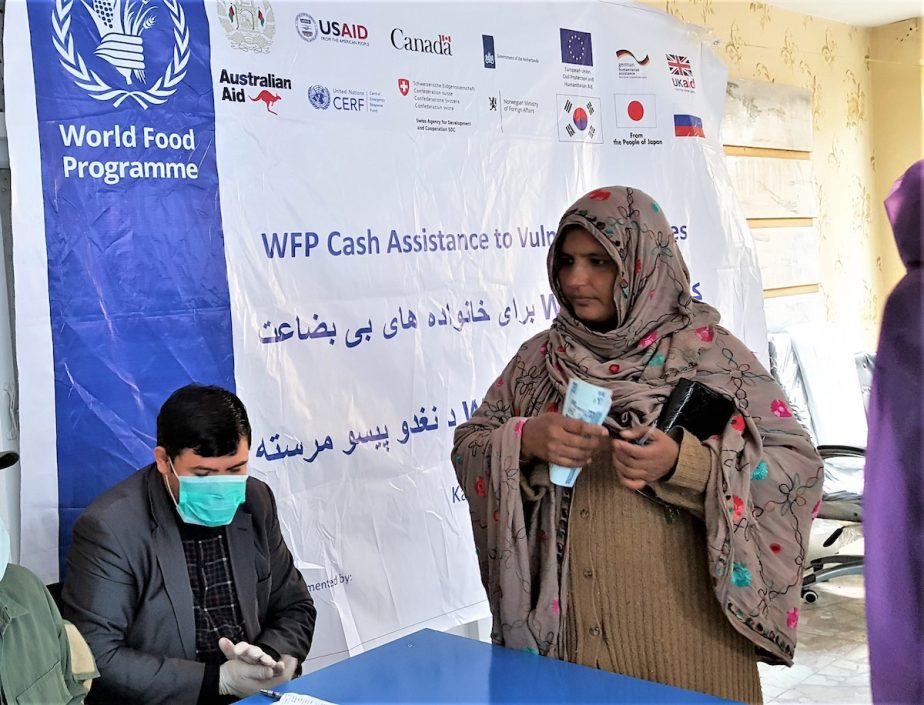When Mahfooza heard on the radio about border closures and lockdowns in cities in Afghanistan, her first thought was how she and her family of seven would survive without any stocks of food.
“I cannot stay at home,” she says. “I need to go out every day to make money to buy food. Already, we’ve heard about food prices rises in the markets and shops across the country.”
Mahfooza lives in the Baharak district of Takhar Province, in the northeast of Afghanistan. Her family is among the thousands in the country who do not know where their next meal will come from. Authorities there have ordered citizens to stay at home, devastating income streams.
The World Food Program (WFP) continues to assist food-insecure families during the COVID-19 pandemic, with measures in place to protect everyone involved in delivering it, from those receiving food to the various actors who facilitate that (including people from partner agencies).
When the border between Pakistan and Afghanistan was closed to quell the spread of COVID-19 in mid-March, food prices in the capital Kabul jumped by up to 30 percent overnight. The government moved to curb excessive pricing within hours, but the prices of staple foods have managed to increase gradually nonetheless.
Daily market price analysis by WFP, for eight important provincial markets across the country, shows that within two weeks the price of wheat flour had increased by 19 percent.
Mahfooza and her family, one of the poorest in the community, were already selected for seasonal support to help them get through the lean season.
Upon entering the distribution site, she washes her hands with water and soap and during the distribution, she keeps a one-metre distance from other recipients of food assistance and humanitarian workers.
Across the country, WFP is taking concrete measures to protect the people we serve, partners and staff from infection and spread of the coronavirus. Distributions are staggered to allow for fewer people to gather at any given time, sensitization material is on display and workers wear protective personal equipment. Families receive food or cash to cover their food needs for two months in one go.
Participants in vocational training programs receive their food assistance while they wait for classes to resume.

Takhar province, Afghanistan: Staff from a WFP partner identify registered food assistance recipients using the agency’s digital platform, SCOPE. Photo: WFP/Shelter for Life
Masooma
Every evening, 37-year-old Masooma dons a burqa and walks for an hour to a neighbourhood far away from the house where she lives with relatives, occupying one room with her six children and her brother-in-law, who has special needs. She finds a different bakery every day next to which she sits on the ground and begs customers for pieces of bread. She hopes that the darkness of the night, and the burqa itself, will keep anyone from recognizing her.
“Begging is considered a shameful act in the community,” she says. “But I have no other way to feed my children.” Her husband left her seven years ago to find work in Iran. He is rumoured to take taken another wife or become an opium addict. He never sent home any money to Masooma.
These days, her worries of public shame are amplified by fears of over coronavirus. “Today I got bread from 15 different people,” she says. “These are generous people who gave me food for my children. But maybe one of them is sick and I will catch the disease.”
The lockdown of Kabul with an estimated 6 million residents also scares her. “If the shops are closed and the bakeries are not operating, there will be no customers and we will die from hunger before we get killed by the virus,” says Massoma.
Masooma spoke to WFP at a cash distribution site for most vulnerable families in the capital, where she received 3,000 afghani ($40). This money will allow her to buy enough food to cover her family’s needs for one month without having to go out and beg. “I will buy wheat flour, oil and cooking gas,” she says. “This will help me stay in my home and protect from the coronavirus.”

Food-insecure families currently receive two months’ worth of seasonal support. Photo: WFP/Shelter for Life
Obaidullah
Being unable to afford food on the market is a fear echoed by vulnerable families across the country. Obaidullah, a farmer in Taktha Pol district of Kandahar Province in the south of Afghanistan, says: “We are people from the countryside, we don’t know what kind of calamity this is. Everyone is worried and we hear that it can infect any of us or our families.” He has, however, heard how the coronavirus can spread, and is wearing a surgical mask when he arrives at the site.
He is one of 2,000 farmers in the district to receive in-kind food assistance to help his family get through the lean season to the next harvest, starting in May.
Obaidullah has received wheat flour, vegetable oil, pulses and salt from WFP. He has heard about COVID-19 but the information in rural areas of the country is scant and rumors are rampant. “We are rural people, we don’t know what kind of calamity this is, everyone is worried about what will happen. Thank God we have food now and do not need to go to the market for some time.”
In a space of two weeks, more than 115,000 Afghan citizens returned from Iran, according to the International Organization for Migration. They will rejoin their already vulnerable families across the country, increasing the risk of spreading the coronavirus and exacerbating the food insecurity of communities that no longer receive money from their migrant workforce.
WFP, together with the wider humanitarian community, is gearing up to assist families for three months and has published the COVID-19: Multi-Sector Humanitarian Country Plan calling for US$108 million. The Food Security and Agriculture Cluster requires additional funding of US$18.7 million to provide life-saving food assistance to 220,000 additional people to be reached in districts where most Afghan returnees from Iran are expected to rejoin their families.
The United Nations Humanitarian Air Service (UNHAS) requires additional funding of US$7.5 million to continue operations, transporting aid workers during the response to COVID-19. This includes US$3 million for an air bridge, in the event all international flights remain suspended.

Cash assistance helps families stay safe at home and abide by the lockdowns authorities have called for. Photo: WFP/Mohammad Yasin Hessari
Wahidullah Amani is from Afghanistan. He grew up during the Soviet invasion, spent his school years under the Taliban control, and went on to become a journalist. He is now a communications officer with WFP. He lives with his family in Kabul.
For more information on WFP’s work in Afghanistan click here.

































